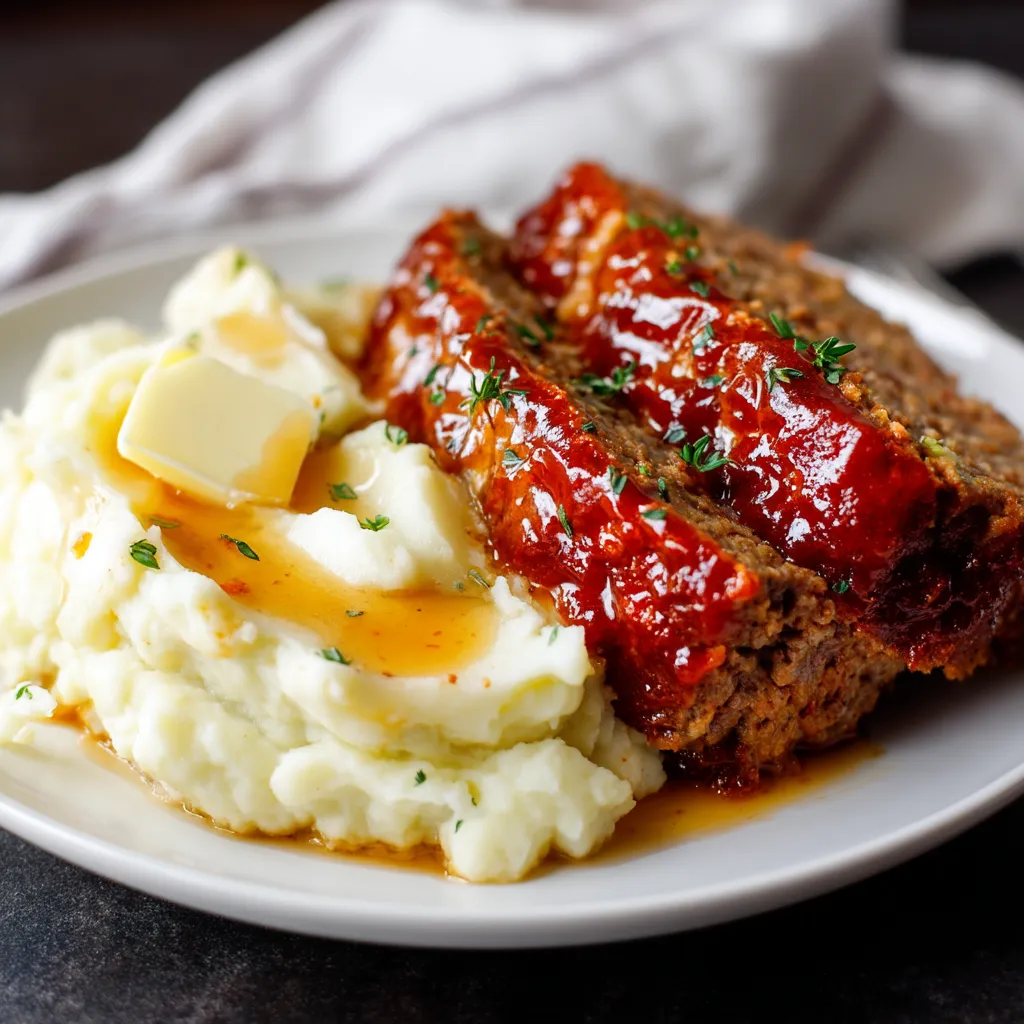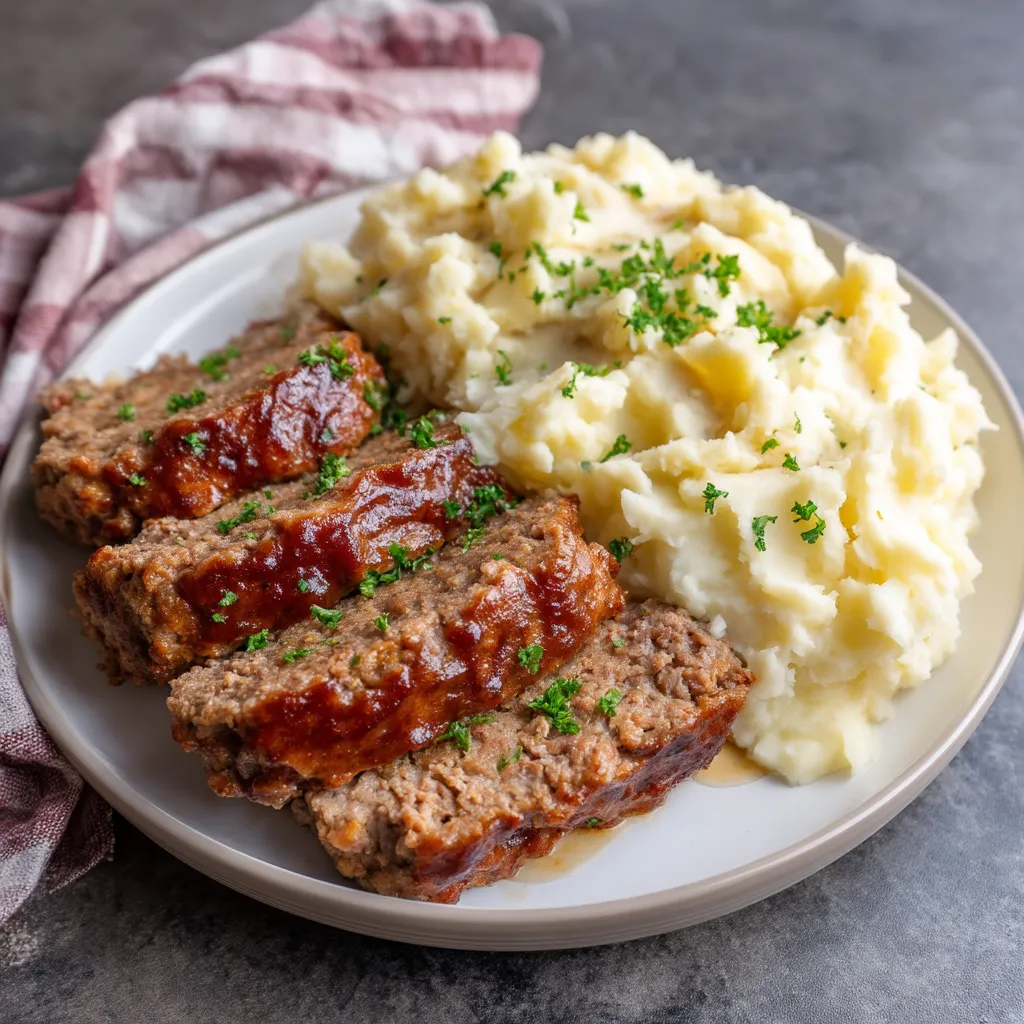 Save It
Save It This classic meatloaf with buttery mashed potatoes brings me back to Sunday family dinners at my grandmother's house. The combination of juicy, flavorful meat topped with that sweet-tangy glaze alongside creamy potatoes creates the ultimate comfort food experience that satisfies even the pickiest eaters in my household.
I started making this recipe when my children were young and picky eaters. The familiar flavors and comforting texture became our Thursday night tradition, and now my adult children request it whenever they visit home.
Ingredients
For the meatloaf
- Ground beef: 80/20 preferred for the perfect balance of flavor and juiciness without becoming greasy
- Breadcrumbs: Provide structure while keeping the meatloaf tender. Fresh work best but panko or regular dry crumbs work well too
- Onion and garlic: Form the aromatic base that gives the meatloaf its classic savory flavor
- Eggs: Bind everything together preventing the meatloaf from falling apart during slicing
- Milk: Adds moisture and tenderness to the meat mixture
- Ketchup: In the mixture provides subtle sweetness and moisture
- Worcestershire sauce: Adds that umami depth that makes people ask for your secret ingredient
- Dried herbs: Bring warmth and dimension to the flavor profile
For the glaze
- Ketchup: Creates that classic shiny top layer everyone loves to scrape off first
- Brown sugar: Caramelizes beautifully in the oven creating those delicious darkened edges
- Apple cider vinegar or Dijon: Cuts through the richness with a pleasant tang
For the mashed potatoes
- Yukon Gold potatoes: Have the perfect starch content for creamy mashed potatoes with minimal effort
- Butter: Is non negotiable for that rich silky mouthfeel
- Warm milk or cream: Prevents the potatoes from becoming gluey or cold
- Salt and white pepper: Season without visible specks in your creamy potatoes
Step-by-Step Instructions
- Preheat and Prepare:
- Turn your oven to 350°F and prepare your baking vessel. I prefer lining with parchment for easy cleanup and removal. The parchment also prevents the bottom from overcooking which can happen with direct contact to the pan.
- Mix the Meatloaf:
- Combine all meatloaf ingredients in a large bowl using clean hands. This is where technique matters tremendously. Mix only until the ingredients are evenly distributed about 30 seconds of gentle folding. Overmixing compacts the proteins making your meatloaf dense and tough rather than tender.
- Shape the Loaf:
- Form the meat mixture into a loaf shape roughly 9 inches long by 5 inches wide. I prefer free forming on a parchment lined baking sheet rather than using a loaf pan as it allows for better browning all around. If using a loaf pan ensure it's at least 9x5 inches to allow proper cooking.
- Prepare and Apply the Glaze:
- Whisk together the ketchup brown sugar and vinegar or mustard until completely smooth. Spread this mixture generously over the entire top and sides of your meatloaf. This not only adds flavor but creates a protective layer that keeps moisture inside.
- Bake to Perfection:
- Place the meatloaf in the preheated oven and bake until the internal temperature reaches 160°F. This typically takes about an hour but starts checking at the 50 minute mark as ovens vary. The glaze should be caramelized and slightly darkened at the edges.
- Rest the Meatloaf:
- Allow the meatloaf to rest for a full 10 minutes before slicing. This crucial step allows the juices to redistribute throughout the meat rather than running out when cut prematurely resulting in a much juicier final product.
- Prepare the Potatoes:
- While the meatloaf bakes start your potatoes in cold salted water. This ensures even cooking from the inside out. Bring to a boil and cook until a fork slides in easily about 15 to 20 minutes depending on the size of your potato chunks.
- Finish the Mashed Potatoes:
- Drain the potatoes thoroughly then return them to the hot pot. This step allows excess moisture to evaporate resulting in fluffier potatoes. Add butter while potatoes are still hot so it melts completely then mash until smooth. Stir in warmed milk gradually until you reach your desired consistency. Season generously with salt and white pepper.
 Save It
Save It The Worcestershire sauce in this recipe is my secret weapon. I learned from my mother that this fermented condiment adds a depth of flavor that elevates the meatloaf from ordinary to memorable. When friends ask what makes my meatloaf special this is the ingredient I credit though I sometimes pretend to keep it secret just for fun.
Make Ahead Options
This meatloaf mixture can be prepared up to 24 hours ahead and refrigerated. Simply prepare everything up to the baking step, cover tightly with plastic wrap, and refrigerate. When ready to cook, remove from the refrigerator about 30 minutes before baking to take the chill off, then add an extra 10-15 minutes to the cooking time. The cold center will need a bit longer to reach the proper temperature. I often prepare the meat mixture the night before when expecting company, which makes dinner assembly quick and stress-free.
Storage and Leftovers
Leftover meatloaf might be even better than the fresh version. Store cooled meatloaf and potatoes separately in airtight containers in the refrigerator for up to 4 days. To reheat meatloaf, slice it first then warm in a covered skillet with a tablespoon of beef broth or water for moisture. The potatoes will thicken in the refrigerator, so add a splash of warm milk when reheating and stir well. My favorite way to enjoy leftover meatloaf is actually between two slices of good bread with mayo and a bit of extra ketchup for a classic meatloaf sandwich.
 Save It
Save It Customization Ideas
This recipe is wonderfully adaptable to your family's preferences. For a lighter version, substitute ground turkey for the beef, but add 2 tablespoons of olive oil to maintain moisture. For added nutrition, finely chop bell peppers or grate zucchini into the mix. My children love when I add 1/2 cup of shredded cheddar cheese to both the meatloaf mixture and the mashed potatoes. For an elevated version, try roasting a head of garlic and incorporating the softened cloves into both the meatloaf and potatoes for a sophisticated flavor upgrade that still maintains the comfort food appeal.
Troubleshooting Tips
If your meatloaf tends to crack during baking, make sure you're not packing it too tightly. Form it with gentle hands and avoid pressing down firmly. For potatoes that seem gluey, you likely overworked them while hot. Next time, mash them just until smooth and fold in liquids gently. If your meatloaf seems to fall apart when slicing, it might need more binding elements - add an extra egg or 1/4 cup more breadcrumbs to your next batch. Remember that good meatloaf should be tender but should still hold its shape when cut.
Common Questions About Recipes
- → Can I use a spiral-cut ham for this recipe?
Yes, spiral-cut hams work beautifully with this glaze. The pre-cut slices allow the glaze to penetrate deeper into the meat. Just be careful not to overbake as spiral hams can dry out more quickly than uncut hams. Reduce the cooking time by about 15-20 minutes and check for doneness earlier.
- → How do I know when the ham is fully heated?
Since you're starting with a fully-cooked ham, you're primarily heating it through rather than cooking it. The ham is ready when it reaches an internal temperature of 140°F (60°C) at its thickest part. Use a meat thermometer for accuracy. The outside should be nicely caramelized with a glossy appearance.
- → Can I make the glaze ahead of time?
Absolutely! The glaze can be prepared up to 3 days in advance and stored in an airtight container in the refrigerator. Warm it slightly before using to restore its consistency for easier brushing. This is a great time-saving step for holiday preparations.
- → What can I substitute for pineapple if I don't have any?
If pineapple isn't available, you can substitute with orange juice and slices, apricot preserves, or peach preserves with a tablespoon of lemon juice for acidity. These alternatives will create a different but equally delicious flavor profile while maintaining the sweet-tangy balance needed for the glaze.
- → How should I store and reheat leftovers?
Store leftover ham in an airtight container in the refrigerator for up to 5 days. For best results when reheating, place ham slices in a baking dish with a splash of water or pineapple juice, cover with foil, and heat at 325°F (165°C) until warmed through. This prevents the ham from drying out.
- → Can I freeze this glazed ham?
Yes, leftover ham freezes well for up to 2 months. Slice it first for easier portioning, then wrap tightly in freezer paper or plastic wrap before placing in freezer bags. Thaw overnight in the refrigerator before reheating. The texture remains good, though the glaze might not be as shiny after freezing.